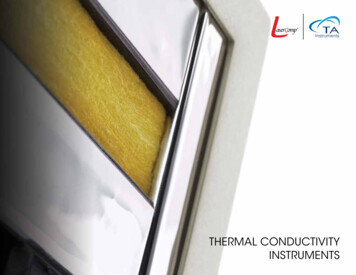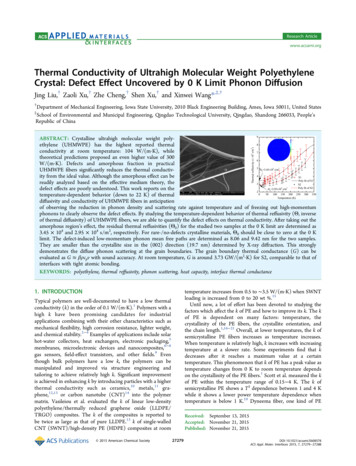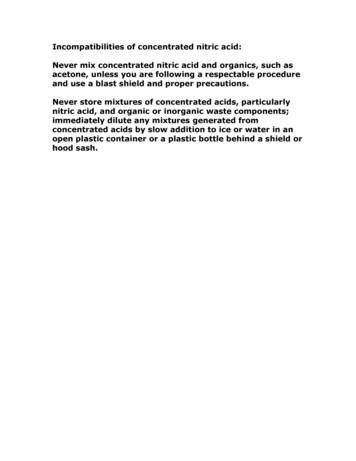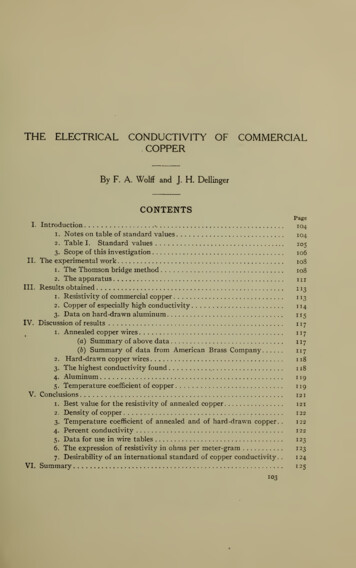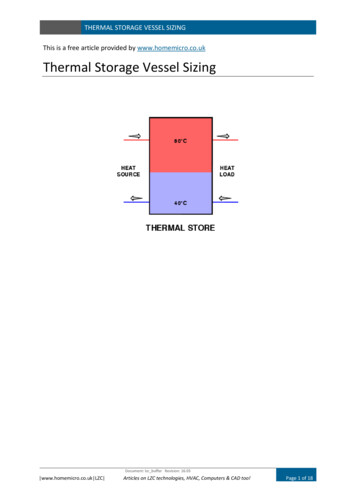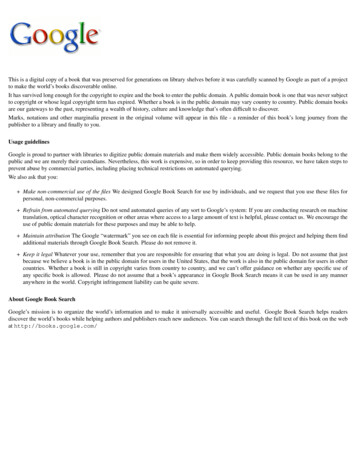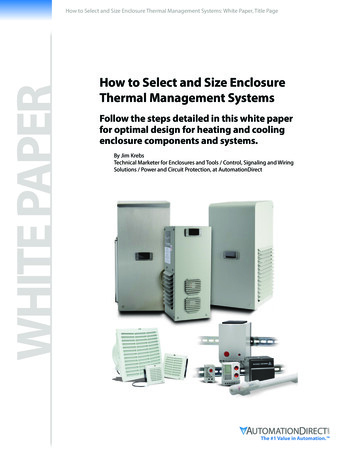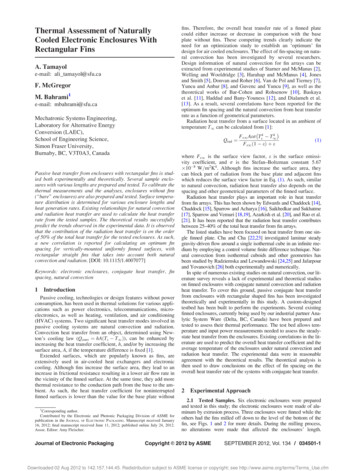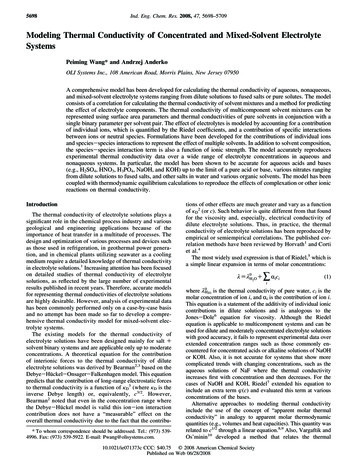
Transcription
5698Ind. Eng. Chem. Res. 2008, 47, 5698–5709Modeling Thermal Conductivity of Concentrated and Mixed-Solvent ElectrolyteSystemsPeiming Wang* and Andrzej AnderkoOLI Systems Inc., 108 American Road, Morris Plains, New Jersey 07950A comprehensive model has been developed for calculating the thermal conductivity of aqueous, nonaqueous,and mixed-solvent electrolyte systems ranging from dilute solutions to fused salts or pure solutes. The modelconsists of a correlation for calculating the thermal conductivity of solvent mixtures and a method for predictingthe effect of electrolyte components. The thermal conductivity of multicomponent solvent mixtures can berepresented using surface area parameters and thermal conductivities of pure solvents in conjunction with asingle binary parameter per solvent pair. The effect of electrolytes is modeled by accounting for a contributionof individual ions, which is quantified by the Riedel coefficients, and a contribution of specific interactionsbetween ions or neutral species. Formulations have been developed for the contributions of individual ionsand species-species interactions to represent the effect of multiple solvents. In addition to solvent composition,the species-species interaction term is also a function of ionic strength. The model accurately reproducesexperimental thermal conductivity data over a wide range of electrolyte concentrations in aqueous andnonaqueous systems. In particular, the model has been shown to be accurate for aqueous acids and bases(e.g., H2SO4, HNO3, H3PO4, NaOH, and KOH) up to the limit of a pure acid or base, various nitrates rangingfrom dilute solutions to fused salts, and other salts in water and various organic solvents. The model has beencoupled with thermodynamic equilibrium calculations to reproduce the effects of complexation or other ionicreactions on thermal conductivity.IntroductionThe thermal conductivity of electrolyte solutions plays asignificant role in the chemical process industry and variousgeological and engineering applications because of theimportance of heat transfer in a multitude of processes. Thedesign and optimization of various processes and devices suchas those used in refrigeration, in geothermal power generation, and in chemical plants utilizing seawater as a coolingmedium require a detailed knowledge of thermal conductivityin electrolyte solutions.1 Increasing attention has been focusedon detailed studies of thermal conductivity of electrolytesolutions, as reflected by the large number of experimentalresults published in recent years. Therefore, accurate modelsfor representing thermal conductivities of electrolyte solutionsare highly desirable. However, analysis of experimental datahas been commonly performed only on a case-by-case basisand no attempt has been made so far to develop a comprehensive thermal conductivity model for mixed-solvent electrolyte systems.The existing models for the thermal conductivity ofelectrolyte solutions have been designed mainly for salt solvent binary systems and are applicable only up to moderateconcentrations. A theoretical equation for the contributionof interionic forces to the thermal conductivity of diluteelectrolyte solutions was derived by Bearman2,3 based on theDebye-Hückel-Onsager-Falkenhagen model. This equationpredicts that the contribution of long-range electrostatic forcesto thermal conductivity is a function of κD3 (where κD is theinverse Debye length) or, equivalently, c3/2. However,Bearman2 noted that even in the concentration range wherethe Debye-Hückel model is valid this ion-ion interactioncontribution does not have a “measurable” effect on theoverall thermal conductivity due to the fact that the contribu* To whom correspondence should be addressed. Tel.: (973) 5394996. Fax: (973) 539-5922. E-mail: Pwang@olisystems.com.tions of other effects are much greater and vary as a functionof κD2 (or c). Such behavior is quite different from that foundfor the viscosity and, especially, electrical conductivity ofdilute electrolyte solutions. Thus, in practice, the thermalconductivity of electrolyte solutions has been reproduced byempirical or semiempirical correlations. The published correlation methods have been reviewed by Horvath1 and Cortiet al.4The most widely used expression is that of Riedel,5 which isa simple linear expansion in terms of molar concentrations:λ ) λH0 2O Rci i(1)iwhere λH0 2O is the thermal conductivity of pure water, ci is themolar concentration of ion i, and Ri is the contribution of ion i.This equation is a statement of the additivity of individual ioniccontributions in dilute solutions and is analogous to theJones-Dole6 equation for viscosity. Although the Riedelequation is applicable to multicomponent systems and can beused for dilute and moderately concentrated electrolyte solutionswith good accuracy, it fails to represent experimental data overextended concentration ranges such as those commonly encountered for concentrated acids or alkaline solutions of NaOHor KOH. Also, it is not accurate for systems that show morecomplicated trends with changing concentrations, such as theaqueous solutions of NaF where the thermal conductivityincreases first with concentration and then decreases. For thecases of NaOH and KOH, Riedel7 extended his equation toinclude an extra term φ(c) and evaluated this term at variousconcentrations of the bases.Alternative approaches to modeling thermal conductivityinclude the use of the concept of “apparent molar thermalconductivity” in analogy to apparent molar thermodynamicquantities (e.g., volumes and heat capacities). This quantity wasrelated to c1/2 through a linear equation.8,9 Also, Vargaftik andOs’minin10 developed a method that relates the thermal10.1021/ie071373c CCC: 40.75 2008 American Chemical SocietyPublished on Web 06/28/2008
Ind. Eng. Chem. Res., Vol. 47, No. 15, 2008 5699Figure 1. Excess thermal conductivity of the water ethylene glycol system at 50 C as a function of (a) mole fraction and (b) weight fraction of ethyleneglycol. The excess thermal conductivities, λxex and λwex, are defined as λxex ) λm - k xkλk and λwex ) λm - k wkλk. Symbols are from experimental data ofVanderkooi et al.50Table 1. r Coefficients in Equations 18 for Selected Aqueous IonsR1,H2Ocations H3OLi Na K Mg2 Ca2 Ba2 NH4 Fe3 Fe2 Ni2 Cu2 Zn2 Cr3 R2,H2O-0.716 880-0.207 0410.0-0.382 485-0.496 250-0.052 799-0.651 0550.045 80-1.141 49-1.524 35-0.281 946-0.975 205-0.971 744-1.139483anions0.289 7190.057 6910.00.0449 320.0526 520.126 5190.065 461-0.358 17-0.536 220.771 680.007 328-0.098 870.055 408-0.536 2,H2O-0.360 439-0.422 374-0.029 457-1.235 530.492 307 60.059 371-0.215 6900.341 711-0.168 580.217 76-0.541 150.006 0760.033 7170.044 9030.120 45-0.018 014-0.108 86-0.167 0370.0-1.140 83-0.271 540.319 69the model of Qureshi et al.11 is accurate for the solutions studied,it is applicable only to aqueous binary systems.In mixed-solvent electrolyte solutions, thermal conductivityis determined not only by the concentration of electrolytes, butalso by the composition of the solvent. The thermal conductivityof solvent mixtures alone may change significantly withcomposition. In addition, in systems with strong ion associationeffect (e.g., in fully miscible acids or bases), thermal conductivity is influenced by concentrations of both ions and associatedion pairs. Thus, a comprehensive treatment of thermal conductivity of mixed-solvent electrolyte systems requires taking intoaccount not only the ion-solvent and ion-ion interactions thatpredominate in aqueous solutions, but also the solvent-solventand ion pair-solvent interactions.The objective of this work is to develop a comprehensive,engineering-oriented model for predicting thermal conductivityof mixed-solvent electrolyte solutions. In this study, the term“mixed-solvent electrolytes” is used in the broadest possiblesense to include (1) aqueous electrolyte solutions from the diluteregion to the molten salt limit, (2) fully miscible acids or basesin water, and (3) electrolytes in pure organic or mixedorganic-water solvents. Further, the model is designed toaccount for speciation effects, such as complexation or ionassociation, when combined with a speciation-based thermodynamic model. The model developed in this study consists oftwo parts: (1) computation of thermal conductivity of pure andconductivity to other properties of the solution and of the solventsuch as the heat capacities and densities. These methods,however, are applicable only to binary electrolyte solutions, andtheir accuracy deteriorates with rising concentration.1 Morerecently, a generalized corresponding-states correlation has beenproposed by Qureshi et al.11 Using two system-dependentparameters for each binary solution and 10 universal parameters,their model has been shown to reproduce the experimental datafor over 20 aqueous electrolyte systems within 4% over wideranges of concentration, pressure, and temperature. AlthoughTable 2. Parameters of Equations 10 and 16 for Selected Solvent Pairssolvent pairsparameters(0)ijkijmethanolH2O0.006 428 7ethanolH2O0.141 844ethylene glycolH2O0.350 350ethylene glycoldiethylene glycol1-propanol2-propanolethanolH2OH2OH2O6.308 360.345 1260.1485370.325 5032-propanolmethanol -0.023 849acetic acidacetoneacetonetolueneH2OH2OCCl4CCl40.238 2840.074 5070.047 927-0.646 339cyclohexaneCCl40.106 991kij(1)T ( C)0.000 863 5 0-70400.000 761 6 0-80-40-70-0.000 510 2 -20-198-40-70-0.027 643-40-70-0.000 362 1 -10-2000.0009413 0-800.000 414 6 0-80400.04040400.023-1390.001 244 3 0-600.00-500.002 4740-4025, 400.025-5025, 4025, 40relevant systemsmethanol H2O2-propanol methanol H2Oethanol H2Oethanol ethylene glycol H2Oethylene glycol H2Oethanol ethylene glycol H2Oethanol ethylene glycol H2Odiethylene glycol H2O1-propanol H2O2-propanol H2O2-propanol methanol H2O2-propanol methanol2-propanol methanol ethylene glycol2-propanol methanol H2Oacetic acid H2Oacetone H2Oacetone CCl4toluene CCl4toluene CCl4 cyclohexanecyclohexane CCl4toluene CCl4 cyclohexanebenzene CCl4 cyclohexaneno. of points 3, 45–4714, 43, 46–5346,14,14,14,4748, 54, 554343, 4444564314, 5714, 17, 5817, 57, 58
5700 Ind. Eng. Chem. Res., Vol. 47, No. 15, 2008Thermal Conductivity of Solvent MixturesFigure 2. Thermal conductivity of the water acetic acid system as afunction of temperature at various fixed compositions (in mass percent) ofacetic acid. Experimental data are from Bleazard et al.,56 and the lines arecalculated from eqs 2, 8, 10, and 16 using parameters listed in Table 2.Figure 3. Thermal conductivity of organic water mixtures as a function ofthe mole fraction of water at 20 C. The symbols are experimental data fromRastorgu and Ganiev,43 Lei et al.,45 and Bates et al.,42 and the lines are calculatedfrom eqs 2, 8, 10, and 16 using the parameters listed in Table 2.Figure 4. Percentage deviations for the prediction of thermal conductivitiesas a function of the mole fraction of cyclohexane for ternary systemscyclohexane CCl4 benzene and cyclohexane CCl4 toluene.Experimental data are from Rowley et al.17 and Rowley and Gubler.58mixed solvents as a function of temperature and solventcomposition and (2) computation of the dependence of thermalconductivity on electrolyte concentration.It has been observed in the literature that thermal conductivities of liquid mixtures are usually lower than either a moleor weight fraction average of pure-component conductivities.12 Various models for representing the thermal conductivity of liquid mixtures have been described in the literature.Some notable models that are applicable to multicomponentsystems include the power law method,13 the harmonic meanmethod of Li14 and its modification,15 and models based onthe local composition concept such as those of Rowley,16,17Cao et al.,18 and Huang.19 Although the power law methodhas been successfully used for a number of liquid mixtures,it is limited to nonaqueous mixtures and the ratio of thermalconductivities of any two pure components can not exceed2.12 The harmonic method of Li fails to predict the thermalconductivity behavior of azeotropic liquid mixtures.14 Correlations based on the corresponding-states principle20–23 havealso been proposed for calculating the thermal conductivityof liquids and liquid mixtures. The results obtained from thesemethods depend on the selection of reference fluids, whichmay have a substantial influence on the calculated valuesfor liquid mixtures, especially when the system goes beyondbinary. Several hard-sphere theory-based models have beendeveloped for organic mixtures.24–26 However, these modelsare focused on mixtures containing components with similarchemical structures. A number of other correlation methodshave been limited only to binary systems.12In this section, we develop a new correlation that relates thethermal conductivity of solvent mixtures to those of purecomponents. This correlation is targeted primarily at mixturescontaining dissimilar components such as water and organicsbecause of the preeminence of such solvents in electrolytesystems. The local composition concept embodied in theUNIQUAC model of Abrams and Prausnitz27 has been used toderive the correlation. This approach relies on the use of localarea fractions to represent the local compositions, which appearsto be a more appropriate choice than using the mole fractionsfor modeling energy transport in liquid mixtures.14 The structuralparameters used in this approach are readily available in theliterature.12It has been previously noted16 that the weight fraction averageof thermal conductivity ( k wkλ0k ), rather than the mole fractionaverage ( k xkλ0k ), leads to a more symmetrical “excess thermalconductivity”, λ
28.06.2008 · reactions on thermal conductivity. Introduction The thermal conductivity of electrolyte solutions plays a significant role in the chemical process industry and various geological and engineering applications because of the importance of heat transfer in a multitude of processes. The design and optimization of various processes and devices such

